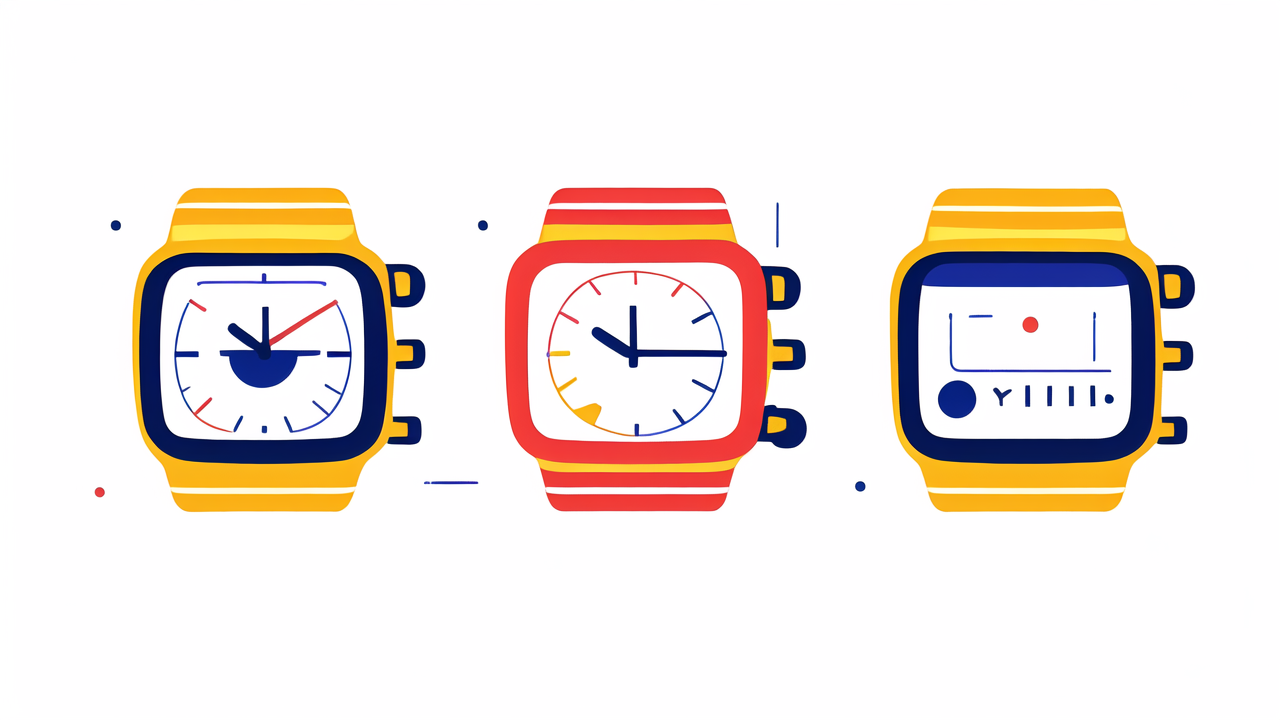Understanding the Differences Between Smart Bands and Smartwatches
The Evolution of Wearable Technology: From Fitbit to Apple Watch
Wearable tech has come a long way since Fitbit's first step counter. It's a journey from simple trackers to smart devices on our wrists. Let's look at this exciting evolution.

Fitbit started the trend in 2009 with a clip-on step counter. It was basic but revolutionary. People loved tracking their daily steps. This small device sparked a fitness tracking boom.
As technology improved, so did wearables. They added heart rate monitors and sleep tracking. Fitness bands became more advanced. They could do more than just count steps.
Then came smartwatches. They took wearables to a new level. The Apple Watch, launched in 2015, was a game-changer. It combined fitness tracking with smartphone features.
Now, we have a wide range of options. From simple fitness bands to advanced smartwatches, there's something for everyone. These devices keep getting smarter and more stylish.
Wearables are now part of our daily lives. They help us stay fit, connected, and organized. The future looks bright for this technology. Who knows what amazing features we'll see next?
Key Features That Distinguish Smart Bands from Smartwatches
Smart bands and smartwatches may seem similar, but they have key differences. Let's explore what sets them apart.
Smart bands focus on fitness tracking. They're simpler devices with these main features:
- Step counting
- Heart rate monitoring
- Sleep tracking
- Basic notifications
Smartwatches offer more functions. They're like mini-computers on your wrist. Here's what they typically include:
- All features of smart bands
- Larger, touch-sensitive screens
- Ability to run apps
- Make calls and send messages
- GPS navigation
- Mobile payments
Smart bands are usually smaller and have longer battery life. They're great for fitness enthusiasts who want simple tracking. Smartwatches are more versatile but need charging more often.
Price is another factor. Smart bands are generally cheaper than smartwatches. This makes them a good entry point for wearable tech.
In the end, the choice depends on what you need. Do you want basic fitness tracking or a full-featured wrist computer? Think about your lifestyle and needs when choosing.
User Preference: Choosing the Wearable that Best Fits Your Lifestyle
Choosing between a smart band and a smartwatch depends on your lifestyle. Let's look at how to make this choice.
For fitness fans, a smart band might be best. These devices are light and focus on health tracking. They're perfect for workouts and don't get in the way. Their long battery life means less charging.
If you're always on the go, a smartwatch could be better. It keeps you connected without reaching for your phone. You can check emails, answer calls, and use apps from your wrist.
Think about your daily routine. Do you need constant connectivity? Or do you prefer a simpler device that tracks your health? Your answer will guide your choice.
Style is another factor. Smart bands are usually more discreet. Smartwatches can be fashion statements. Consider what fits your personal style.
Comfort is key. You'll wear this device a lot, so it should feel good on your wrist. Try different options if you can.
Remember, the best choice is the one you'll use consistently. Pick a device that enhances your lifestyle without being a hassle.
The Impact of Smart Bands and Smartwatches on the Fashion Industry
Trends in Wearable Fashion: How Smart Bands and Watches are Changing the Game
Wearable tech is no longer just about function. It's becoming a fashion statement. Smart bands and watches are changing how we think about accessories.

Designers are now creating stylish wearables. They're moving beyond plain plastic bands. We're seeing sleek metal finishes and leather straps. These devices are becoming as much about looks as they are about tech.
Color trends in wearables often match fashion trends. Rose gold became popular in both jewelry and smartwatches. Many devices now offer customizable faces. This lets users match their wearable to their outfit.
Collaborations between tech companies and fashion brands are common. For example, Apple has worked with Hermès on special edition watches. Fitbit has partnered with designers like Tory Burch.
The rise of wearables has also influenced traditional watch design. Many classic watch brands now offer "hybrid" watches. These combine traditional looks with smart features.
As wearables become more fashionable, they're entering high-end retail. Luxury stores now stock smartwatches alongside traditional timepieces. This blend of fashion and tech is creating new opportunities in both industries.
The Fusion of Technology and Fashion: Consumer Trends in the United States
In the U.S., tech and fashion are coming together in exciting ways. Let's look at how Americans are embracing this trend.
Wearable tech is no longer just for tech lovers. It's becoming mainstream fashion. Many Americans now see their smartwatch or fitness tracker as a key accessory.
Customization is a big trend. Users want devices that match their style. This has led to more options in bands and watch faces. People treat their wearables like their phones – as an extension of themselves.
Health and wellness are major drivers. Many Americans use wearables to track fitness and manage health. This trend has grown even stronger since the pandemic.
There's a growing demand for versatile devices. People want wearables that look good in all settings. They should work for the gym, office, and night out.
Sustainability is becoming more important. Consumers are looking for eco-friendly options in all products, including wearables. This is pushing brands to think about materials and production methods.
The line between fashion and tech continues to blur. As wearables become more stylish, and fashion becomes more high-tech, we're seeing a true fusion of these industries.
How Smartwatches are Redefining the Watchmaking Industry
Smartwatches have shaken up the traditional watch industry. They've forced watchmakers to innovate and adapt. Let's explore this impact.
Traditional watchmakers faced a challenge when smartwatches arrived. Many saw their sales drop as consumers chose tech-filled wrists. But the industry has responded in creative ways.
Some luxury brands have embraced smartwatches. TAG Heuer and Montblanc now offer high-end smart timepieces. They blend traditional craftsmanship with modern tech.
Other watchmakers are adding smart features to classic designs. These "hybrid" watches look traditional but offer things like activity tracking and notifications. It's a way to appeal to tech-savvy customers who still appreciate classic style.
The rise of smartwatches has also renewed interest in watches overall. Younger consumers who might not have worn a watch are now doing so. This has created new opportunities for all types of watches.
Smartwatches have pushed innovation in battery life and materials. These advancements benefit the entire watch industry. We're seeing more durable, longer-lasting watches as a result.
The watchmaking industry is evolving. It's finding ways to combine centuries of tradition with cutting-edge technology. This blend is creating exciting new products for consumers.
Selecting the Best Smart Band or Smartwatch for You
Health and Fitness Goals: Finding the Wearable that Aligns with Your Lifestyle
Choosing the right wearable for your health and fitness goals is important. Let's look at how to match your needs with the right device.

For serious athletes, advanced fitness tracking is key. Look for devices with:
- Accurate heart rate monitoring
- GPS for route tracking
- Specialized sport modes
- Recovery metrics
If you're just starting your fitness journey, a simpler device might be better. Consider one with:
- Step counting
- Basic activity tracking
- Sleep monitoring
- Motivational features
For those managing health conditions, certain features are important:
- Continuous heart rate monitoring
- Blood oxygen measurement
- Stress tracking
- Medication reminders
Think about where and how you'll use the device. Swimmers need water resistance. Outdoor enthusiasts might want rugged design and long battery life.
Remember, the best device is one you'll wear consistently. Choose something comfortable that fits your daily routine. This way, you're more likely to stick with it and reach your health goals.
Lifestyle and Convenience: Balancing Functionality with Style
When choosing a wearable, think about how it fits into your daily life. It's about finding the right balance of features and style.
For busy professionals, convenience is key. Look for devices that offer:
- Easy notifications for calls and messages
- Calendar alerts
- Voice assistants for quick tasks
If style is important to you, consider:
- Devices with customizable faces
- Interchangeable bands
- Sleek designs that work with different outfits
For those always on the go, battery life is crucial. Some smart bands can last a week or more on a single charge. Smartwatches usually need charging every 1-2 days.
Think about your hobbies and interests. Do you need music control during workouts? Or maybe contactless payments for quick shopping trips?
Remember, the goal is to enhance your lifestyle, not complicate it. Choose a device that makes your daily tasks easier and more efficient.
Consider how the device will look in different settings. A sporty smartwatch might be great for the gym but could look out of place in a formal meeting.
Pricing and Adoption: The Financial and Social Considerations
When choosing a wearable, price and social factors play a big role. Let's look at what to consider.
Smart bands are generally cheaper than smartwatches. They're a good starting point if you're new to wearables. Prices can range from $30 to $150.
Smartwatches offer more features but at a higher cost. They typically range from $150 to $400 or more for premium models.
Consider the long-term value. A more expensive device might offer features that save you time or money in the long run.
Think about compatibility with your current devices. Some wearables work best with specific phone brands. This could affect your choice.
Social aspects matter too. Some people prefer the status of a well-known brand. Others like being part of a fitness community through their device.
Consider privacy. More advanced devices collect more data. Make sure you're comfortable with what's being tracked and shared.
Remember, adoption often depends on your social circle. If friends use a certain brand, you might benefit from shared features or challenges.
Ultimately, choose a device that fits your budget and aligns with your values. The right wearable should enhance your life without causing financial stress.




Leave a comment
This site is protected by hCaptcha and the hCaptcha Privacy Policy and Terms of Service apply.